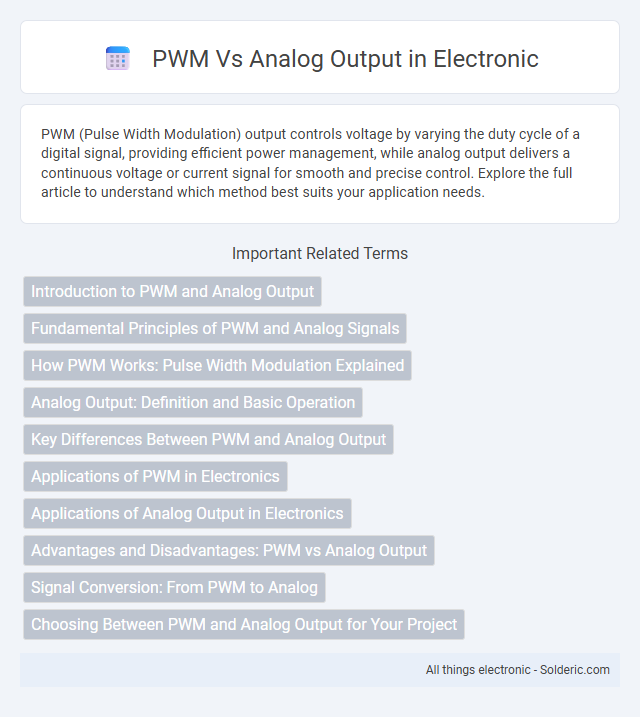PWM (Pulse Width Modulation) output controls voltage by varying the duty cycle of a digital signal, providing efficient power management, while analog output delivers a continuous voltage or current signal for smooth and precise control. Explore the full article to understand which method best suits your application needs.
Comparison Table
| Feature | PWM Output | Analog Output |
|---|---|---|
| Signal Type | Digital pulse width modulated signal | Continuous voltage or current signal |
| Output Range | Discrete levels based on duty cycle (0-100%) | Continuous variable voltage/current (e.g., 0-10V, 4-20mA) |
| Resolution | Depends on timer frequency and counter bits | High, limited by DAC precision |
| Noise Susceptibility | Less noise prone due to digital nature | More prone to noise interference |
| Complexity | Requires modulation and filtering for analog-like output | Simpler with direct output capability |
| Power Efficiency | High efficiency with switching devices | Lower, continuous power dissipation |
| Common Applications | Motor speed control, LED dimming, power regulation | Industrial controls, instrumentation, audio signals |
Introduction to PWM and Analog Output
Pulse Width Modulation (PWM) controls the power delivered to devices by varying the duty cycle of a digital signal, creating an efficient way to simulate analog output. Analog output provides a continuous voltage level, directly representing the desired signal without switching, often requiring digital-to-analog converters (DACs) for precise control. Understanding the differences between PWM and analog output helps you select the optimal method for applications like motor control, LED dimming, or audio signals.
Fundamental Principles of PWM and Analog Signals
PWM (Pulse Width Modulation) signals control power by varying the duty cycle of a fixed frequency digital waveform, enabling efficient energy delivery and precise control in electronic devices. Analog signals represent continuously varying voltage or current levels, providing smooth and direct signal modulation essential for applications requiring fine resolution. Your choice between PWM and analog output depends on the need for power efficiency, signal fidelity, and the complexity of the control system.
How PWM Works: Pulse Width Modulation Explained
Pulse Width Modulation (PWM) works by rapidly switching a digital signal between on and off states to simulate varying voltage levels, effectively controlling the power delivered to a device. The duty cycle, expressed as a percentage, determines the average output voltage by adjusting the ratio of the on-time to the total cycle time. Unlike analog output, which provides a continuous voltage range, PWM achieves efficient power control using digital pulses.
Analog Output: Definition and Basic Operation
Analog output delivers a continuous voltage or current signal that directly corresponds to the desired measurement or control parameter, providing smooth and precise control in systems like audio amplification or motor speed regulation. Unlike PWM signals, which use rapid switching to simulate varying voltage levels, analog outputs produce a steady, uninterrupted waveform essential for applications requiring high fidelity and minimal noise. Your systems benefit from analog output's true signal representation, ensuring accurate and reliable performance in sensitive instrumentation and control scenarios.
Key Differences Between PWM and Analog Output
PWM (Pulse Width Modulation) output varies the duty cycle of a digital signal to represent analog values, while analog output delivers a continuous voltage or current signal proportional to the desired output. PWM signals are energy-efficient and easier to generate with digital microcontrollers, making them suitable for motor control and LED dimming, whereas analog outputs provide smoother and more precise signals for audio and sensor applications. Understanding these key differences helps you select the appropriate method for your project's performance and accuracy requirements.
Applications of PWM in Electronics
PWM is widely used in electronics for motor speed control, LED dimming, and power regulation due to its efficiency and precision. It enables fine adjustment of power delivery by varying the duty cycle, making it ideal for applications requiring energy savings and thermal management. Your projects benefit from PWM's ability to provide stable and adjustable outputs without the complexity of analog voltage control.
Applications of Analog Output in Electronics
Analog output in electronics is crucial for applications requiring precise voltage or current control, such as audio signal processing, sensor interfacing, and industrial automation systems. It enables smooth and continuous signal variation, essential for controlling actuators, variable power supplies, and instrumentation devices. Unlike PWM, analog output provides direct, noise-free signals, making it ideal for high-fidelity and real-time response applications.
Advantages and Disadvantages: PWM vs Analog Output
PWM (Pulse Width Modulation) offers high efficiency and precise control of power delivery, making it ideal for applications like motor speed regulation and LED dimming, while its switching nature can introduce electromagnetic interference (EMI). Analog output provides smooth, continuous voltage levels beneficial for applications requiring fine signal quality and minimal noise, but often suffers from higher power dissipation and less efficient control compared to PWM. Choosing between PWM and analog output depends on factors such as power efficiency, signal fidelity, and application-specific noise tolerance.
Signal Conversion: From PWM to Analog
PWM signals convert to analog output using low-pass filters that smooth the rapid on-off switching into a continuous voltage level. The filter's cutoff frequency is critical for reducing ripple and ensuring a stable DC voltage proportional to the PWM duty cycle. Accurate analog conversion depends on filter design parameters such as resistor-capacitor values and the PWM base frequency.
Choosing Between PWM and Analog Output for Your Project
Choosing between PWM and analog output depends on the application requirements and hardware compatibility. PWM signals provide efficient digital control for devices like LEDs and motors by varying duty cycles to simulate analog levels, while true analog output offers precise voltage levels ideal for sensitive sensors and audio equipment. Consider factors such as resolution, noise tolerance, and component support when selecting the best output type for your project's accuracy and performance needs.
PWM vs Analog output Infographic

 solderic.com
solderic.com